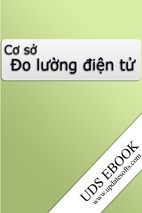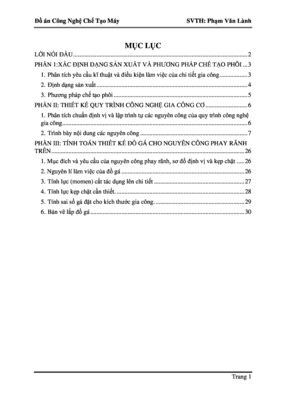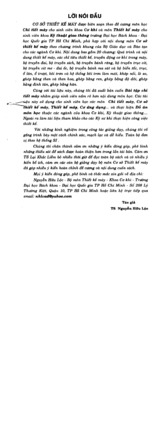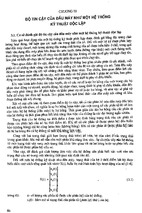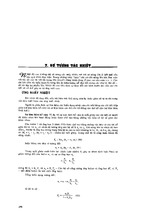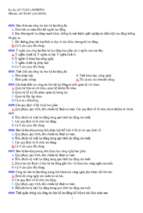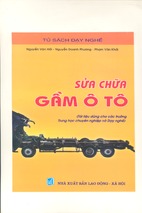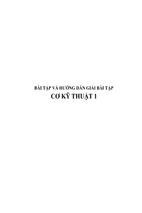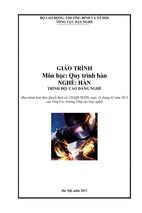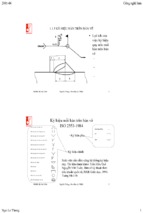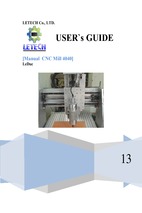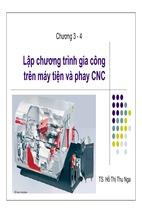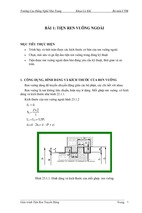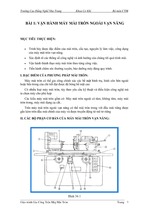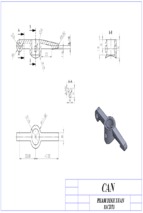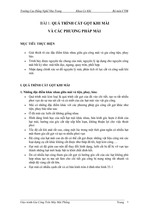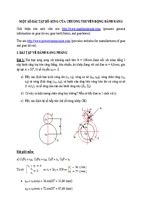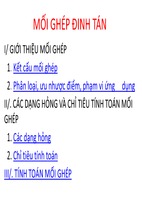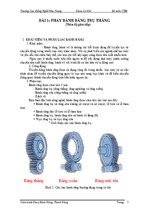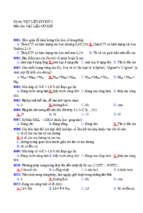Machining Technology Machine Tools and Operations
CRC_43390_FM.indd i
3/25/2008 5:13:23 PM
CRC_43390_FM.indd ii
3/25/2008 5:13:25 PM
CRC_43390_FM.indd iii
3/25/2008 5:13:25 PM
CRC Press
Taylor & Francis Group
6000 Broken Sound Parkway NW, Suite 300
Boca Raton, FL 33487-2742
© 2008 by Taylor & Francis Group, LLC
CRC Press is an imprint of Taylor & Francis Group, an Informa business
No claim to original U.S. Government works
Printed in the United States of America on acid-free paper
10 9 8 7 6 5 4 3 2 1
International Standard Book Number-13: 978-1-4200-4339-6 (Hardcover)
This book contains information obtained from authentic and highly regarded sources Reasonable efforts have been
made to publish reliable data and information, but the author and publisher cannot assume responsibility for the validity of all materials or the consequences of their use. The Authors and Publishers have attempted to trace the copyright
holders of all material reproduced in this publication and apologize to copyright holders if permission to publish in this
form has not been obtained. If any copyright material has not been acknowledged please write and let us know so we may
rectify in any future reprint
Except as permitted under U.S. Copyright Law, no part of this book may be reprinted, reproduced, transmitted, or utilized in any form by any electronic, mechanical, or other means, now known or hereafter invented, including photocopying, microfilming, and recording, or in any information storage or retrieval system, without written permission from the
publishers.
For permission to photocopy or use material electronically from this work, please access www.copyright.com (http://
www.copyright.com/) or contact the Copyright Clearance Center, Inc. (CCC) 222 Rosewood Drive, Danvers, MA 01923,
978-750-8400. CCC is a not-for-profit organization that provides licenses and registration for a variety of users. For organizations that have been granted a photocopy license by the CCC, a separate system of payment has been arranged.
Trademark Notice: Product or corporate names may be trademarks or registered trademarks, and are used only for
identification and explanation without intent to infringe.
Library of Congress Cataloging-in-Publication Data
Youssef, Helmi A.
Machining technology : machine tools and operations / Helmi A. Youssef, Hassan El-Hofy.
p. cm.
Includes bibliographical references and index.
ISBN 978-1-4200-4339-6 (hardback : alk. paper) 1. Machining. 2. Machine-tools. I. El-Hofy, Hassan.
II. Title.
TJ1185.Y68 2008
671.3’5--dc22
2008008302
Visit the Taylor & Francis Web site at
http://www.taylorandfrancis.com
and the CRC Press Web site at
http://www.crcpress.com
CRC_43390_FM.indd iv
3/25/2008 5:13:25 PM
To our grandsons and granddaughters,
Omar, Youssef, Nour, Anourine, Fayrouz, and Yousra
CRC_43390_FM.indd v
3/25/2008 5:13:25 PM
CRC_43390_FM.indd vi
3/25/2008 5:13:26 PM
Contents
Preface ............................................................................................................................................xix
Acknowledgments ........................................................................................................................ xxiii
Editors ............................................................................................................................................xxv
List of Symbols ............................................................................................................................xxvii
List of Acronyms ....................................................................................................................... xxxiii
Chapter 1
Machining Technology.................................................................................................1
1.1
1.2
1.3
1.4
Introduction ...............................................................................................................................1
History of Machine Tools .........................................................................................................1
Basic Motions in Machine Tools...............................................................................................5
Aspects of Machining Technology ........................................................................................... 5
1.4.1 Machine Tool .................................................................................................................6
1.4.2 Workpiece Material ....................................................................................................... 9
1.4.3 Machining Productivity .................................................................................................9
1.4.4 Accuracy and Surface Integrity................................................................................... 10
1.4.5 Product Design for Economical Machining ................................................................ 10
1.4.6 Environmental Impacts of Machining ........................................................................ 10
1.5 Review Questions .................................................................................................................... 10
References ........................................................................................................................................ 10
Chapter 2
Basic Elements and Mechanisms of Machine Tools .................................................. 11
2.1 Introduction ............................................................................................................................. 11
2.2 Machine Tool Structures ......................................................................................................... 13
2.2.1 Light- and Heavy-weight Constructions ...................................................................... 17
2.3 Machine Tool Guideways ........................................................................................................ 18
2.3.1 Sliding Friction Guideways ......................................................................................... 18
2.3.2 Rolling Friction Guideways ......................................................................................... 21
2.3.3 Externally Pressurized Guideways .............................................................................. 22
2.4 Machine Tool Spindles............................................................................................................ 23
2.4.1 Spindle Bearings ......................................................................................................... 23
2.4.2 Selection of Spindle-Bearing Fit .................................................................................25
2.4.3 Sliding Friction Spindle Bearing ................................................................................. 27
2.5 Machine Tool Drives ...............................................................................................................28
2.5.1 Stepped Speed Drives..................................................................................................28
2.5.1.1 Belting ...........................................................................................................28
2.5.1.2 Pick-Off Gears .............................................................................................. 30
2.5.1.3 Gearboxes...................................................................................................... 30
2.5.1.4 Stepping of Speeds According to Arithmetic Progression ........................... 31
2.5.1.5 Stepping of Speeds According to Geometric Progression ............................ 32
2.5.1.6 Kinetic Calculations of Speed Gearboxes .................................................... 35
2.5.1.7 Application of Pole-Changing Induction Motors.......................................... 35
2.5.1.8 Feed Gearboxes ............................................................................................ 37
2.5.1.9 Preselection of Feeds and Speeds ................................................................. 39
vii
CRC_43390_FM.indd vii
3/25/2008 5:13:26 PM
viii
Contents
2.5.2 Stepless Speed Drives .................................................................................................40
2.5.2.1 Mechanical Stepless Drives .........................................................................40
2.5.2.2 Electrical Stepless Speed Drive ................................................................... 42
2.5.2.3 Hydraulic Stepless Speed Drive ................................................................... 43
2.6 Planetary Transmission ..........................................................................................................44
2.7 Machine Tool Motors ............................................................................................................. 45
2.8 Reversing Mechanisms ........................................................................................................... 45
2.9 Couplings and Brakes .............................................................................................................46
2.10 Reciprocating Mechanisms .................................................................................................... 48
2.10.1 Quick-Return Mechanism ........................................................................................... 48
2.10.2 Whitworth Mechanism ................................................................................................ 50
2.10.3 Hydraulic Reciprocating Mechanism ......................................................................... 50
2.11 Material Selection and Heat Treatment of Machine Tool Components ................................. 51
2.11.1 Cast Iron ...................................................................................................................... 51
2.11.2 Steels............................................................................................................................ 52
2.12 Testing of Machine Tools ....................................................................................................... 53
2.13 Maintenance of Machine Tools .............................................................................................. 55
2.13.1 Preventive Maintenance .............................................................................................. 56
2.13.2 Corrective Maintenance .............................................................................................. 56
2.13.3 Reconditioning ............................................................................................................ 56
2.14 Review Questions ................................................................................................................... 57
References ........................................................................................................................................ 57
Chapter 3
General-Purpose Machine Tools ................................................................................ 59
3.1
3.2
Introduction ............................................................................................................................ 59
Lathe Machines and Operations ............................................................................................. 59
3.2.1 Turning Operations...................................................................................................... 59
3.2.2 Metal Cutting Lathes ...................................................................................................60
3.2.2.1 Universal Engine Lathes ...............................................................................60
3.2.2.2 Other Types of General-Purpose Metal Cutting Lathes ............................... 69
3.3 Drilling Machines and Operations ......................................................................................... 70
3.3.1 Drilling and Drilling Allied Operations ..................................................................... 70
3.3.1.1 Drilling Operation......................................................................................... 70
3.3.1.2 Drilling Allied Operations ............................................................................ 71
3.3.2 General-Purpose Drilling Machines ........................................................................... 74
3.3.2.1 Bench-Type Sensitive Drill Presses .............................................................. 74
3.3.2.2 Upright Drill Presses..................................................................................... 74
3.3.2.3 Radial Drilling Machines ............................................................................. 76
3.3.2.4 Multispindle Drilling Machines.................................................................... 76
3.3.2.5 Horizontal Drilling Machines for Drilling Deep Holes ............................... 77
3.3.3 Tool Holding Accessories of Drilling Machines ......................................................... 77
3.3.4 Work-Holding Devices Used on Drilling Machines ................................................... 79
3.4 Milling Machines and Operations .......................................................................................... 82
3.4.1 Milling Operations ...................................................................................................... 82
3.4.1.1 Peripheral Milling ......................................................................................... 82
3.4.1.2 Face Milling ..................................................................................................84
3.4.2 Milling Cutters ............................................................................................................84
CRC_43390_FM.indd viii
3/25/2008 5:13:26 PM
Contents
ix
3.4.3
General-Purpose Milling Machines ........................................................................... 86
3.4.3.1 Knee-Type Milling Machines ....................................................................... 86
3.4.3.2 Vertical Bed-Type Milling Machines............................................................ 88
3.4.3.3 Planer-Type Milling Machine ....................................................................... 88
3.4.3.4 Rotary-Table Milling Machines .................................................................... 89
3.4.4 Holding Cutters and Workpieces on Milling Machines .............................................90
3.4.4.1 Cutter Mounting ............................................................................................90
3.4.4.2 Workpiece Fixturing ..................................................................................... 91
3.4.5 Dividing Heads ...........................................................................................................94
3.4.5.1 Universal Dividing Heads .............................................................................94
3.4.5.2 Modes of Indexing ........................................................................................ 95
3.5 Shapers, Planers, and Slotters and Their Operations ..............................................................99
3.5.1 Shaping, Planing, and Slotting Processes....................................................................99
3.5.1.1 Determination of vcm in Accordance with the Machine Mechanism.......... 101
3.5.2 Shaper and Planer Tools ............................................................................................ 102
3.5.3 Shapers, Planers, and Slotters.................................................................................... 103
3.5.3.1 Shapers ........................................................................................................ 103
3.5.3.2 Planers ......................................................................................................... 105
3.5.3.3 Slotters......................................................................................................... 107
3.6 Boring Machines and Operations ........................................................................................ 107
3.6.1 Boring ........................................................................................................................ 107
3.6.2 Boring Tools .............................................................................................................. 108
3.6.2.1 Types of Boring Tools ................................................................................. 108
3.6.2.2 Materials of Boring Tools ........................................................................... 109
3.6.3 Boring Machines ....................................................................................................... 109
3.6.3.1 General-Purpose Boring Machines............................................................. 109
3.6.3.2 Jig Boring Machines ................................................................................... 110
3.7 Broaching Machines and Operations .................................................................................... 111
3.7.1 Broaching .................................................................................................................. 111
3.7.1.1 Advantages and Limitations of Broaching ................................................. 112
3.7.2 The Broach Tool ........................................................................................................ 113
3.7.2.1 Tool Geometry and Configuration .............................................................. 113
3.7.2.2 Broach Material .......................................................................................... 116
3.7.2.3 Broach Sharpening ...................................................................................... 116
3.7.3 Broaching Machines .................................................................................................. 116
3.7.3.1 Horizontal Broaching Machines ................................................................. 117
3.7.3.2 Vertical Broaching Machines...................................................................... 118
3.7.3.3 Continuous Horizontal Surface Broaching Machines ................................ 118
3.8 Grinding Machines and Operations ...................................................................................... 119
3.8.1 Grinding Process ....................................................................................................... 119
3.8.2 Grinding Wheels ....................................................................................................... 122
3.8.2.1 Manufacturing Characteristics of Grinding Wheels .................................. 122
3.8.2.2 Grinding Wheel Geometry ......................................................................... 127
3.8.2.3 Mounting and Balancing of Grinding Wheels and Safety Measures ......... 127
3.8.2.4 Turning and Dressing of Grinding Wheels................................................. 130
3.8.3 Grinding Machines .................................................................................................... 131
3.8.3.1 Surface Grinding Machines and Related Operations ................................. 132
3.8.3.2 External Cylindrical Grinding Machines and Related Operations ............ 133
3.8.3.3 Internal Grinding Machines and Related Operations ................................. 136
3.8.3.4 Centerless Grinding Machines and Related Operations ............................. 137
CRC_43390_FM.indd ix
3/25/2008 5:13:26 PM
x
Contents
3.9
Microfinishing Machines and Operations ............................................................................ 141
3.9.1 Honing ....................................................................................................................... 141
3.9.1.1 Process Capabilities .................................................................................... 142
3.9.1.2 Machining Parameters ................................................................................ 144
3.9.1.3 Honing Machines ........................................................................................ 145
3.9.2 Superfinishing (Microhoning) ................................................................................... 145
3.9.3 Lapping ...................................................................................................................... 147
3.9.3.1 Machining Parameters ................................................................................ 147
3.9.3.2 Lapping Machines ....................................................................................... 148
3.10 Review Questions .................................................................................................................. 154
References ...................................................................................................................................... 156
Chapter 4
Thread Cutting ......................................................................................................... 157
4.1 Introduction ........................................................................................................................... 157
4.2 Thread Cutting ...................................................................................................................... 159
4.2.1 Cutting Threads on the Lathe.................................................................................... 160
4.2.2 Thread Chasing ......................................................................................................... 163
4.2.3 Thread Tapping ......................................................................................................... 164
4.2.4 Die Threading............................................................................................................ 168
4.2.4.1 Die Threading Machines ............................................................................ 169
4.2.4.2 Die Threading Performance........................................................................ 172
4.2.5 Thread Milling .......................................................................................................... 172
4.2.6 Thread Broaching ...................................................................................................... 175
4.3 Thread Grinding ................................................................................................................... 175
4.3.1 Center-Type Thread Grinding ................................................................................... 175
4.3.2 Centerless Thread Grinding ...................................................................................... 177
4.4 Review Questions .................................................................................................................. 178
References ...................................................................................................................................... 179
Chapter 5
Gear Cutting Machines and Operations................................................................... 181
5.1 Introduction ........................................................................................................................... 181
5.2 Forming and Generating Methods in Gear Cutting.............................................................. 183
5.2.1 Gear Cutting by Forming .......................................................................................... 184
5.2.1.1 Gear Milling................................................................................................ 184
5.2.1.2 Gear Broaching ........................................................................................... 188
5.2.1.3 Gear Forming by a Multiple-Tool Shaping Head ........................................ 189
5.2.1.4 Straight Bevel Gear Forming Methods ....................................................... 190
5.2.2 Gear Cutting by Generation ...................................................................................... 190
5.2.2.1 Gear Hobbing .............................................................................................. 190
5.2.2.2 Gear Shaping with Pinion Cutter ................................................................ 198
5.2.2.3 Gear Shaping with Rack Cutter ..................................................................202
5.2.2.4 Cutting Straight Bevel Gears by Generation ..............................................202
5.3 Selection of Gear Cutting Method ........................................................................................207
5.4 Gear Finishing Operations ....................................................................................................207
5.4.1 Finishing Gears Prior to Hardening ..........................................................................207
5.4.1.1 Gear Shaving ...............................................................................................207
5.4.1.2 Gear Burnishing .......................................................................................... 211
5.4.2 Finishing Gears After Hardening.............................................................................. 212
5.4.2.1 Gear Grinding ............................................................................................. 212
5.4.3 Gear Lapping ............................................................................................................. 214
CRC_43390_FM.indd x
3/25/2008 5:13:26 PM
Contents
xi
5.5 Review Questions and Problems ........................................................................................... 215
References ...................................................................................................................................... 215
Chapter 6
Turret and Capstan Lathes ....................................................................................... 217
6.1
6.2
6.3
6.4
Introduction ........................................................................................................................... 217
Difference Between Capstan and Turret Lathes ................................................................... 217
Selection and Application of Capstan and Turret Lathes ..................................................... 219
Principal Elements of Capstan and Turret Lathes ................................................................ 219
6.4.1 Headstock and Spindle Assembly ............................................................................. 220
6.4.2 Carriage/Cross-Slide Unit ......................................................................................... 221
6.4.3 Hexagonal Turret ....................................................................................................... 221
6.4.3.1 Manually Controlled Machines .................................................................. 222
6.4.3.2 Automatically Controlled Headstock Turret Lathes ................................... 222
6.4.4 Cross-Sliding Hexagonal Turret ................................................................................ 223
6.5 Turret Tooling Setups ............................................................................................................ 223
6.5.1 Job Analysis ............................................................................................................... 223
6.5.2 Tooling Layout........................................................................................................... 226
6.6 Review Questions .................................................................................................................. 232
References ...................................................................................................................................... 232
Chapter 7
Automated Lathes .................................................................................................... 233
7.1
7.2
7.3
7.4
Introduction ........................................................................................................................... 233
Degree of Automation and Production Capacity .................................................................. 234
Classification of Automated Lathes ...................................................................................... 235
Semiautomatic Lathes ........................................................................................................... 237
7.4.1 Single-Spindle Semiautomatics ................................................................................. 237
7.4.2 Multispindle Semiautomatics .................................................................................... 239
7.5 Fully Automatic Lathes......................................................................................................... 241
7.5.1 Single-Spindle Automatic.......................................................................................... 241
7.5.1.1 Turret Automatic Screw Machine ............................................................... 241
7.5.1.2 Swiss-Type Automatic ................................................................................. 252
7.5.2 Horizontal Multispindle Bar and Chucking Automatics ........................................... 256
7.5.2.1 Special Features of Multispindle Automatics ............................................ 256
7.5.2.2 Characteristics of Parallel- and Progressive-Action
Multispindle Automatic .............................................................................. 258
7.5.2.3 Operation Principles and Constructional Features of a
Progressive Multispindle Automatic ...........................................................260
7.6 Design and Layout of Cams for Fully Automatics ...............................................................266
7.6.1 Planning a Sequence of Operation and a Tooling Layout ......................................... 267
7.6.2 Cam Design ............................................................................................................... 268
7.7 Review Questions and Problems ........................................................................................... 283
References ......................................................................................................................................284
Chapter 8
Numerical Control and Computer Numerical Control Technology ......................... 285
8.1 Introduction ........................................................................................................................... 285
8.2 Coordinate System ................................................................................................................290
8.2.1 Machine Tool Axes for NC .......................................................................................290
8.2.2 Quadrant Notation ..................................................................................................... 292
8.2.3 Point Location ........................................................................................................... 292
8.2.4 Zero Point Location ................................................................................................... 293
CRC_43390_FM.indd xi
3/25/2008 5:13:27 PM
xii
Contents
8.2.5 Setup Point................................................................................................................. 293
8.2.6 Absolute and Incremental Positioning....................................................................... 293
8.3 Machine Movements in Numerical Control Systems ........................................................... 294
8.4 Interpolation ......................................................................................................................... 296
8.5 Control of Numerical Control Machine Tools ...................................................................... 297
8.6 Components of Numerical Control Machine Tools .............................................................. 299
8.7 Tooling for Numerical Control Machines ............................................................................302
8.8 Numerical Control Machine Tools ....................................................................................... 305
8.9 Input Units ............................................................................................................................308
8.10 Forms of Numerical Control Instructions ............................................................................ 310
8.11 Program Format .................................................................................................................... 311
8.12 Feed and Spindle Speed Coding ........................................................................................... 312
8.12.1 Feed Rate Coding ...................................................................................................... 312
8.12.2 Spindle Speed Coding ............................................................................................... 314
8.13 Features of Numerical Control Systems ............................................................................... 314
8.14 Part Programming ................................................................................................................ 316
8.15 Programming Machining Centers ........................................................................................ 320
8.15.1 Planning the Program ................................................................................................ 320
8.15.2 Canned Cycles ........................................................................................................... 322
8.16 Programming Turning Centers ............................................................................................. 328
8.16.1 Planning the Program ................................................................................................ 328
8.16.2 Canned Turning Cycles ............................................................................................. 331
8.17 Computer-Assisted Part Programming................................................................................. 334
8.17.1 Automatically Programmed Tools Language............................................................ 334
8.17.2 Programming Stages ................................................................................................. 337
8.18 CAD/CAM Approach to Part Programming ........................................................................ 339
8.18.1 Computer-Aided Design ............................................................................................ 339
8.18.2 Computer-Aided Manufacturing ............................................................................... 339
8.19 Review Questions .................................................................................................................340
References ...................................................................................................................................... 343
Chapter 9
Hexapods and Machining Technology ..................................................................... 345
9.1
9.2
9.3
Introduction .......................................................................................................................... 345
Historical Background .......................................................................................................... 345
Hexapod Mechanism and Design Features ..........................................................................348
9.3.1 Hexapod Mechanism .................................................................................................348
9.3.2 Design Features ......................................................................................................... 349
9.3.2.1 Hexapods of Telescopic Struts (Ingersoll System)...................................... 349
9.3.2.2 Hexapods of Ball Screw Struts (Hexel and Geodetic System) ................... 352
9.4 Hexapod Constructional Elements ....................................................................................... 354
9.4.1 Strut Assembly .......................................................................................................... 354
9.4.2 Sphere Drive .............................................................................................................. 354
9.4.3 Bifurcated Balls ......................................................................................................... 356
9.4.4 Spindles ..................................................................................................................... 357
9.4.5 Articulated Head ....................................................................................................... 359
9.4.6 Upper Platform .......................................................................................................... 359
9.4.7 Control System .......................................................................................................... 361
9.5 Hexapod Characteristics ....................................................................................................... 362
9.6 Manufacturing Applications ................................................................................................. 366
CRC_43390_FM.indd xii
3/25/2008 5:13:27 PM
Contents
xiii
9.7 Review Questions ................................................................................................................. 368
References ...................................................................................................................................... 369
Chapter 10
Machine Tool Dynamometers ................................................................................ 371
10.1
10.2
Introduction ......................................................................................................................... 371
Design Features of Dynamometers ..................................................................................... 371
10.2.1 Rapier Parameters for Dynamometer Design ....................................................... 372
10.2.2 Main Requirements of a Good Dynamometer ...................................................... 373
10.3 Dynamometers Based on Displacement Measurements ..................................................... 374
10.3.1 Two-Channel Cantilever (Chisholm) Dynamometer ............................................ 374
10.3.2 Two-Channel-Slotted Cantilever Dynamometer................................................... 374
10.4 Dynamometers Based on Strain Measurement ................................................................... 375
10.4.1 Strain Gauges and Wheatstone Bridges ................................................................ 375
10.4.2 Cantilever Strain Gauge Dynamometers .............................................................. 377
10.4.3 Octagonal Ring Dynamometers............................................................................ 378
10.4.3.1 Strain Rings and Octagonal Ring Transducers ..................................... 378
10.4.3.2 Turning Dynamometer .......................................................................... 382
10.4.3.3 Surface Plunge-Cut Grinding Dynamometer ....................................... 384
10.4.3.4 Milling Dynamometers ......................................................................... 384
10.5 Piezoelectric (Quartz) Dynamometers ................................................................................ 384
10.5.1 Principles and Features ......................................................................................... 384
10.5.2 Typical Piezoelectric Dynamometers ................................................................... 386
10.6 Review Questions ................................................................................................................ 389
References ...................................................................................................................................... 390
Chapter 11 Nontraditional Machine Tools and Operations ........................................................ 391
11.1
11.2
11.3
11.4
CRC_43390_FM.indd xiii
Introduction ......................................................................................................................... 391
Classification of Nontraditional Machining Processes ....................................................... 392
Jet Machines and Operations .............................................................................................. 392
11.3.1 Abrasive Jet Machining......................................................................................... 392
11.3.1.1 Process Characteristics and Applications ............................................. 392
11.3.1.2 Work Station of Abrasive Jet Machining .............................................. 395
11.3.1.3 Process Capabilities .............................................................................. 396
11.3.2 Water Jet Machining (Hydrodynamic Machining) ............................................... 397
11.3.2.1 Process Characteristics and Applications ............................................. 397
11.3.2.2 Equipment of WJM ............................................................................... 399
11.3.2.3 Process Capabilities .............................................................................. 401
11.3.3 Abrasive Water Jet Machining .............................................................................402
11.3.3.1 Process Characteristics and Applications .............................................402
11.3.3.2 Abrasive Water Jet Machining Equipment ...........................................405
11.3.3.3 Process Capabilities ..............................................................................409
Ultrasonic Machining Equipment and Operation ............................................................... 410
11.4.1 Definitions, Characteristics, and Applications...................................................... 410
11.4.2 USM Equipment ................................................................................................... 413
11.4.2.1 Oscillating System and Magnetostriction Effect .................................. 413
11.4.2.2 Tool Feeding Mechanism ...................................................................... 418
11.4.3 Design of Acoustic Horns .................................................................................... 419
11.4.3.1 General Differential Equation............................................................... 419
11.4.3.2 Design of the Cylindrical Stepped Acoustic Horns (A(x) = C)............ 421
11.4.3.3 Design of Exponential Acoustic Horns (A(x) = A0e−2hx) ...................... 421
3/25/2008 5:13:27 PM
xiv
Contents
11.4.4
Process Capabilities .............................................................................................. 430
11.4.4.1 Stock Removal Rate .............................................................................. 430
11.4.4.2 Accuracy and Surface Quality .............................................................. 432
11.4.5 Recent Developments ............................................................................................ 433
11.5 Chemical Machining ........................................................................................................... 434
11.5.1 Chemical Milling .................................................................................................. 435
11.5.2 Photochemical Machining (Spray Etching) .......................................................... 441
11.6 Electrochemical Machines and Operations ........................................................................ 445
11.6.1 Process Characteristics and Applications ............................................................ 445
11.6.2 Elements of Electrochemical Machining .............................................................. 447
11.6.2.1 Tool........................................................................................................ 447
11.6.2.2 Workpiece .............................................................................................449
11.6.2.3 Electrolyte ............................................................................................449
11.6.3 ECM Equipment ...................................................................................................449
11.6.4 Process Capabilities .............................................................................................. 451
11.7 Electrochemical Grinding Machines and Operations ........................................................ 453
11.8 Electrical Discharge Machines and Operations.................................................................. 454
11.8.1 Process Characteristics and Applications ............................................................ 454
11.8.2 ED Sinking Machine............................................................................................. 458
11.8.3 EDM-Spark Circuits (Power Supply Circuits) ......................................................460
11.8.3.1 Resistance-Capacitance Circuit ...........................................................460
11.8.3.2 Transistorized Pulse Generator Circuits ............................................... 462
11.8.4 EDM-Tool Electrodes............................................................................................ 463
11.8.5 Process Capabilities ..............................................................................................464
11.8.6 Electrical Discharge Milling.................................................................................465
11.8.7 Electrodischarge Wire Cutting ............................................................................468
11.9 Electron Beam Machining Equipment and Operations ...................................................... 470
11.9.1 Process Characteristics and Applications .............................................................. 470
11.9.2 Electron Beam Machining Equipment .................................................................. 471
11.9.3 Process Capabilities ................................................................................................ 474
11.10 Laser Beam Machining Equipment and Operations .......................................................... 475
11.10.1 Process Characteristics ........................................................................................... 475
11.10.2 Types of Lasers ...................................................................................................... 477
11.10.2.1 Pyrolithic and Photolithic Lasers ........................................................... 477
11.10.2.2 Industrial Lasers ..................................................................................... 477
11.10.2.3 Laser Beam Machining Operations ....................................................... 478
11.10.3 LBM Equipment ..................................................................................................... 481
11.10.4 Applications and Capabilities ................................................................................. 483
11.11 Plasma Arc Cutting Systems and Operations ..................................................................... 485
11.11.1 Process Characteristics ........................................................................................... 485
11.11.2 Plasma Arc Cutting Systems .................................................................................. 486
11.11.3 Applications and Capabilities of Plasma Arc Cutting ............................................ 486
11.12 Review Questions ................................................................................................................ 488
References ...................................................................................................................................... 492
Chapter 12 Environment-Friendly Machine Tools and Operations .......................................... 495
12.1 Introduction ......................................................................................................................... 495
12.2 Traditional Machining ........................................................................................................ 498
12.2.1 Cutting Fluids ......................................................................................................... 501
12.2.1.1 Classification of Cutting Fluids ............................................................... 501
CRC_43390_FM.indd xiv
3/25/2008 5:13:28 PM
Contents
xv
12.2.1.2 Selection of Cutting Fluids ......................................................................502
12.2.1.3 Evaluation of Cutting Fluids ...................................................................502
12.2.2 Hazard Ranking of Cutting Fluids ......................................................................... 503
12.2.3 Health Hazards of Cutting Fluids ...........................................................................504
12.2.4 Cryogenic Cooling ..................................................................................................504
12.2.5 Ecological Machining............................................................................................. 505
12.3 Nontraditional Machining Processes ................................................................................... 510
12.3.1 Chemical Machining .............................................................................................. 510
12.3.2 Electrochemical Machining.................................................................................... 512
12.3.3 Electrodischarge Machining................................................................................... 514
12.3.3.1 Protective Measures ............................................................................... 516
12.3.4 Laser Beam Machining .......................................................................................... 516
12.3.5 Ultrasonic Machining ............................................................................................. 519
12.3.5.1 Electromagnetic Field .............................................................................. 520
12.3.5.2 Ultrasonic Waves ..................................................................................... 520
12.3.5.3 Abrasives Slurry ...................................................................................... 520
12.3.5.4 Contact Hazards ...................................................................................... 521
12.3.5.5 Other Hazards.......................................................................................... 521
12.3.6 Abrasive Jet Machining .......................................................................................... 521
12.4 Review Questions................................................................................................................. 523
References ...................................................................................................................................... 524
Chapter 13
Design for Machining ............................................................................................. 525
13.1 Introduction.......................................................................................................................... 525
13.1.1 General Design Rules ............................................................................................. 525
13.2 General Design Recommendations .................................................................................... 526
13.3 Design for Machining by Cutting ....................................................................................... 528
13.3.1 Turning ................................................................................................................... 528
13.3.1.1 Economic Production Quantities............................................................. 529
13.3.1.2 Design Recommendations for Turning.................................................... 530
13.3.1.3 Dimensional Control ............................................................................... 535
13.3.2 Drilling and Allied Operations............................................................................... 535
13.3.2.1 Economic Production Quantities............................................................. 536
13.3.2.2 Design Recommendations for Drilling and Allied Operations............... 536
13.3.2.3 Dimensional Control ............................................................................... 539
13.3.3 Milling .................................................................................................................... 539
13.3.3.1 Design Recommendations ....................................................................... 539
13.3.3.2 Dimensional Factors and Tolerances ....................................................... 542
13.3.4 Shaping, Planing, and Slotting................................................................................ 542
13.3.4.1 Design Recommendations ....................................................................... 542
13.3.4.2 Dimensional Control ............................................................................... 543
13.3.5 Broaching................................................................................................................544
13.3.5.1 Design Recommendations .......................................................................544
13.3.5.2 Dimensional Factors ................................................................................ 549
13.3.5.3 Recommended Tolerances ....................................................................... 550
13.3.6 Thread Cutting........................................................................................................ 550
13.3.6.1 Design Recommendations ....................................................................... 550
13.3.6.2 Dimensional Factors and Tolerances ....................................................... 551
13.3.7 Gear Cutting ........................................................................................................... 552
13.3.7.1 Design Recommendations ....................................................................... 552
13.3.7.2 Dimensional Factors ................................................................................ 554
CRC_43390_FM.indd xv
3/25/2008 5:13:28 PM
xvi
Contents
13.4 Design for Grinding ............................................................................................................. 554
13.4.1 Surface Grinding .................................................................................................... 554
13.4.1.1 Design Recommendations ....................................................................... 554
13.4.1.2 Dimensional Control ............................................................................... 556
13.4.2 Cylindrical Grinding .............................................................................................. 556
13.4.2.1 Design Recommendations ....................................................................... 556
13.4.2.2 Dimensional Factors ................................................................................ 557
13.4.3 Centerless Grinding ................................................................................................ 557
13.4.3.1 Design Recommendations ....................................................................... 558
13.4.3.2 Dimensional Control ............................................................................... 559
13.5 Design for Finishing Processes............................................................................................ 559
13.5.1 Honing .................................................................................................................... 559
13.5.2 Lapping ................................................................................................................... 560
13.5.3 Superfinishing ......................................................................................................... 561
13.6 Design for Chemical and Electrochemical Machining ....................................................... 561
13.6.1 Chemical Machining .............................................................................................. 561
13.6.1.1 Design Recommendations ....................................................................... 561
13.6.1.2 Dimensional Factors and Tolerances ....................................................... 563
13.6.2 Electrochemical Machining.................................................................................... 563
13.6.2.1 Design Recommendations .......................................................................564
13.6.2.2 Dimensional Factors ................................................................................ 566
13.6.3 Electrochemical Grinding ...................................................................................... 566
13.6.3.1 Design Recommendations ....................................................................... 566
13.6.3.2 Dimensional Factors ................................................................................ 567
13.7 Design for Thermal Machining ........................................................................................... 567
13.7.1 Electrodischarge Machining................................................................................... 567
13.7.1.1 Design Recommendations ....................................................................... 567
13.7.1.2 Dimensional Factors ................................................................................ 568
13.7.2 Electron Beam Machining ...................................................................................... 568
13.7.3 Laser Beam Machining .......................................................................................... 569
13.8 Design for Ultrasonic Machining ........................................................................................ 570
13.9 Design for Abrasive Jet Machining ..................................................................................... 571
13.10 Review Questions................................................................................................................. 572
References ...................................................................................................................................... 573
Chapter 14 Accuracy and Surface Integrity Realized by Machining Processes ........................ 575
14.1
14.2
14.3
14.4
14.5
Introduction.......................................................................................................................... 575
Surface Texture .................................................................................................................... 575
Surface Quality and Functional Properties ......................................................................... 577
Surface Integrity .................................................................................................................. 579
Surface Effects by Traditional Machining........................................................................... 582
14.5.1 Chip Removal Processes......................................................................................... 582
14.5.2 Grinding.................................................................................................................. 583
14.6 Surface Effects by Nontraditional Machining ..................................................................... 587
14.6.1 Electrochemical and Chemical Machining ........................................................... 590
14.6.2 Thermal Nontraditional Processes ......................................................................... 591
14.6.2.1 Electrodischarge Machining ................................................................... 591
14.6.2.2 Laser Beam Machining ........................................................................... 596
14.6.2.3 Electron Beam Machining ...................................................................... 597
14.6.2.4 Plasma Beam Machining (PBM)............................................................. 598
CRC_43390_FM.indd xvi
3/25/2008 5:13:28 PM
Contents
xvii
14.6.2.5 Electroerosion Dissolution Machining .................................................... 598
14.6.2.6 Electrochemical Discharge Grinding ...................................................... 598
14.6.3 Mechanical Nontraditional Processes .................................................................... 599
14.7 Reducing Distortion and Surface Effects in Machining...................................................... 599
14.8 Review Questions................................................................................................................. 601
References ...................................................................................................................................... 601
Chapter 15
Automated Manufacturing System .........................................................................603
15.1 Introduction..........................................................................................................................603
15.2 Manufacturing Systems .......................................................................................................605
15.3 Flexible Automation-Flexible Manufacturing Systems .......................................................609
15.3.1 Elements of Flexible Manufacturing System ......................................................... 610
15.3.2 Limitations of Flexible Manufacturing System...................................................... 611
15.3.3 Features and Characteristics ................................................................................... 611
15.3.4 New Developments in Flexible Manufacturing System Technology ..................... 611
15.4 Computer Integrated Manufacturing ................................................................................... 612
15.4.1 Computer-Aided Design ......................................................................................... 615
15.4.2 Computer-Aided Process Planning......................................................................... 616
15.4.3 Computer-Aided Manufacturing ............................................................................ 617
15.5 Lean Production–Just-in-Time Manufacturing Systems ..................................................... 617
15.5.1 Steps for Implementing the IMPS Lean Production .............................................. 618
15.5.2 Just-in-Time and Just-in-Case Production .............................................................. 619
15.6 Adaptive Control .................................................................................................................. 620
15.7 Smart Manufacturing and Artificial Intelligence ................................................................ 622
15.7.1 Expert Systems ....................................................................................................... 622
15.7.2 Machine Vision ....................................................................................................... 623
15.7.3 Artificial Neural Networks ..................................................................................... 623
15.7.4 Natural-Language Systems ..................................................................................... 624
15.7.5 Fuzzy Logic (Fuzzy Models) .................................................................................. 624
15.8 Factory of the Future ........................................................................................................... 624
15.9 Concluding Remarks Related to Automated Manufacturing .............................................. 625
15.10 Review Questions................................................................................................................. 625
References ...................................................................................................................................... 626
Index .............................................................................................................................................. 627
CRC_43390_FM.indd xvii
3/25/2008 5:13:28 PM
CRC_43390_FM.indd xviii
3/25/2008 5:13:29 PM
Preface
This book provides a comprehensive description of machining technologies related to metal shaping
by material removal techniques, from the basic to the most advanced, in today’s industrial applications. It is a fundamental textbook for undergraduate students enrolled in production, materials and
manufacturing, industrial, and mechanical engineering programs. Students from other disciplines
can also use this book while taking courses in the area of manufacturing and materials engineering. It should be also useful to graduates enrolled in high-level machining technology courses and
professional engineers working in the field of manufacturing industry. The book covers the technologies, machine tools, and operations of several machining processes. The treatment of the different
subjects has been developed from the basic principles of machining processes, machine tool elements,
and control systems, and extends to ecological machining and the most recent machining technologies, including nontraditional methods and hexapod machine tools. Along with the fundamentals
of the conventional and modern machine tools and processes, the book presents environmentalfriendly machine tools and operations; design for machining, accuracy, and surface integrity realized
by machining operations; machining data; and solved examples, problems, and review questions, which
are very useful for undergraduate students and manufacturing engineers facing shop floor problems.
The book is written in 15 chapters, describing for the first time in one book the fundamentals,
basic elements, and operations of general-purpose machine tools used for the production of cylindrical and flat surfaces by turning, drilling and reaming, shaping and planing, and milling processes.
Special-purpose machines and operations used for thread cutting, gear cutting, and broaching processes are also dealt with. Semiautomatic, automatic, NC and CNC machine tools, operations, tooling, mechanisms, accessories, and work fixation are discussed. Abrasion and abrasive finishing
machine tools and operations such as grinding, honing, superfinishing, and lapping are described.
Modern machine tools and operations, dynamometers, and hexapod machine tools and processes
are described. Design for accurate and economic machining, ecological machining, levels of accuracy, and surface finish attained by machining methods are also presented.
OUTLINE OF THE BOOK
In Chapter 1, the history and progress of machining, aspects of machining technology, and the basic
motions of machine tools are introduced. Classification of machine tools and operations in addition
to the basic motions of machining operations are also given.
Chapter 2 introduces the design considerations and requirements of machine tools, including basic
elements such as beds, structures, frames, guideways, spindles and shafts, stepped and stepless drives,
planetary transmission, machine tool motors, couplings, and brakes. Material selection and heat treatment of machine tool elements, and the testing and maintenance of machine tools are also discussed.
Chapter 3 covers general-purpose metal cutting machine tools including lathes, drilling, reaming, jig boring machines, milling machines, and the machine tools of a reciprocating nature such as
shapers, planers, and slotters. Machine tool elements, mechanisms, tooling, accessories, and operations are also explained. Chapter 3 also presents abrasion machine tools, including grinding and
surface finishing machines and processes.
Chapter 4 describes the different types and applications of commonly used screw threads.
Thread machining by cutting and grinding methods are described, together with thread cutting
machines and cutting tools.
In Chapter 5, common types of gears are listed and their applications described. Gear production by machining methods that include cutting, grinding, and lapping are described, together with
their corresponding machine tools and operations.
xix
CRC_43390_FM.indd xix
3/25/2008 5:13:29 PM
- Xem thêm -

